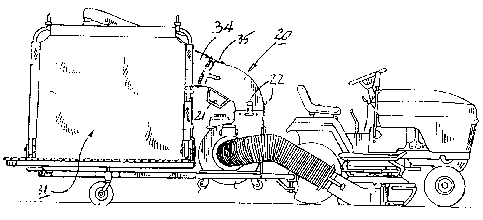Une partie des informations de ce site Web a été fournie par des sources externes. Le gouvernement du Canada n'assume aucune responsabilité concernant la précision, l'actualité ou la fiabilité des informations fournies par les sources externes. Les utilisateurs qui désirent employer cette information devraient consulter directement la source des informations. Le contenu fourni par les sources externes n'est pas assujetti aux exigences sur les langues officielles, la protection des renseignements personnels et l'accessibilité.
L'apparition de différences dans le texte et l'image des Revendications et de l'Abrégé dépend du moment auquel le document est publié. Les textes des Revendications et de l'Abrégé sont affichés :
| (12) Brevet: | (11) CA 2324812 |
|---|---|
| (54) Titre français: | DISPOSITIF DE COLLECTE DE REBUTS ORGANIQUES AVEC UN CONDUIT SOUFFLEUR COURBE |
| (54) Titre anglais: | ORGANIC DEBRIS COLLECTION DEVICE WITH CURVED BLOWER CONDUIT |
| Statut: | Durée expirée - au-delà du délai suivant l'octroi |
| (51) Classification internationale des brevets (CIB): |
|
|---|---|
| (72) Inventeurs : |
|
| (73) Titulaires : |
|
| (71) Demandeurs : |
|
| (74) Agent: | BORDEN LADNER GERVAIS LLP |
| (74) Co-agent: | |
| (45) Délivré: | 2004-09-14 |
| (22) Date de dépôt: | 2000-10-25 |
| (41) Mise à la disponibilité du public: | 2001-09-21 |
| Requête d'examen: | 2000-10-25 |
| Licence disponible: | S.O. |
| Cédé au domaine public: | S.O. |
| (25) Langue des documents déposés: | Anglais |
| Traité de coopération en matière de brevets (PCT): | Non |
|---|
| (30) Données de priorité de la demande: | ||||||
|---|---|---|---|---|---|---|
|
Un conduit d'échappement souffleur courbé, fournissant un courant d'air transportant des solides entraînés réduits en poudre ou granulés dans une chambre close de cargaison substantiellement scellée et de volume fixe, est doté d'un tuyau de ventilation à pression monté sur une région périphérique « interne » du tube courbé ayant un rayon de courbure plus petit que la région périphérique externe du conduit, reliant ainsi l'intérieur du tube courbé vers l'atmosphère externe à un point où la majorité des matières solides entraînées est transportée à proximité de la région périphérique externe par le courant d'air.
A curved blower exhaust conduit, delivering an air stream carrying pulverized or granulated entrained solids to a substantially sealed cargo chamber enclosure of fixed volume, is provided with a pressure relief vent mounted at an "inner" peripheral region of the curved conduit having a smaller radius of curvature than the outer peripheral region of the conduit, thereby connecting the interior of the curved conduit to the external atmosphere at a point where the majority of entrained solids are carried adjacent to the outer peripheral region by the air stream.
Note : Les revendications sont présentées dans la langue officielle dans laquelle elles ont été soumises.
Note : Les descriptions sont présentées dans la langue officielle dans laquelle elles ont été soumises.

2024-08-01 : Dans le cadre de la transition vers les Brevets de nouvelle génération (BNG), la base de données sur les brevets canadiens (BDBC) contient désormais un Historique d'événement plus détaillé, qui reproduit le Journal des événements de notre nouvelle solution interne.
Veuillez noter que les événements débutant par « Inactive : » se réfèrent à des événements qui ne sont plus utilisés dans notre nouvelle solution interne.
Pour une meilleure compréhension de l'état de la demande ou brevet qui figure sur cette page, la rubrique Mise en garde , et les descriptions de Brevet , Historique d'événement , Taxes périodiques et Historique des paiements devraient être consultées.
| Description | Date |
|---|---|
| Inactive : Périmé (brevet - nouvelle loi) | 2020-10-26 |
| Représentant commun nommé | 2019-10-30 |
| Représentant commun nommé | 2019-10-30 |
| Inactive : CIB expirée | 2018-01-01 |
| Inactive : CIB de MCD | 2006-03-12 |
| Inactive : CIB de MCD | 2006-03-12 |
| Inactive : CIB de MCD | 2006-03-12 |
| Accordé par délivrance | 2004-09-14 |
| Inactive : Page couverture publiée | 2004-09-13 |
| Inactive : Grandeur de l'entité changée | 2004-07-13 |
| Préoctroi | 2004-06-28 |
| Inactive : Taxe finale reçue | 2004-06-28 |
| Un avis d'acceptation est envoyé | 2004-01-19 |
| Un avis d'acceptation est envoyé | 2004-01-19 |
| Lettre envoyée | 2004-01-19 |
| Inactive : Approuvée aux fins d'acceptation (AFA) | 2004-01-06 |
| Demande publiée (accessible au public) | 2001-09-21 |
| Inactive : Page couverture publiée | 2001-09-20 |
| Lettre envoyée | 2001-02-28 |
| Inactive : Transfert individuel | 2001-02-06 |
| Inactive : CIB en 1re position | 2001-01-19 |
| Inactive : Lettre de courtoisie - Preuve | 2000-12-12 |
| Inactive : Certificat de dépôt - RE (Anglais) | 2000-12-08 |
| Exigences de dépôt - jugé conforme | 2000-12-08 |
| Demande reçue - nationale ordinaire | 2000-12-07 |
| Exigences pour une requête d'examen - jugée conforme | 2000-10-25 |
| Toutes les exigences pour l'examen - jugée conforme | 2000-10-25 |
Il n'y a pas d'historique d'abandonnement
Le dernier paiement a été reçu le 2003-10-06
Avis : Si le paiement en totalité n'a pas été reçu au plus tard à la date indiquée, une taxe supplémentaire peut être imposée, soit une des taxes suivantes :
Veuillez vous référer à la page web des taxes sur les brevets de l'OPIC pour voir tous les montants actuels des taxes.
Les titulaires actuels et antérieures au dossier sont affichés en ordre alphabétique.
| Titulaires actuels au dossier |
|---|
| WOODLAND POWER PRODUCTS, INC. |
| Titulaires antérieures au dossier |
|---|
| JAMES C. WHITNEY |